Interdisciplinarity within sustainable materials and sustainability education
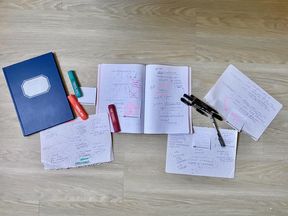
Riia Vidgren, a Master of Science in Chemical, Biochemical and Materials Engineering (/Functional Materials), completed her interdisciplinary Master's thesis in summer this year. Her paper covers the subject of sustainability assessments within material science research which might become crucial for sustainable material development in the near future. Thus, on one autumn afternoon we had a chat with Riia about her thesis and her understanding of the sustainability issue in material development.
-Let's start with a more general question: why do you think this topic had been so intriguing for you that you decided to write your thesis about it? What attracted you in this subject?
-In my previous studies within material science, there wasn't really a lot of discussion on sustainability overall, though it might have changed now, hopefully. When doing my Master's, I got accepted into the Creative Sustainability programme, and that was truly a big change for me! I did know something beforehand about different sustainability dimensions (e.g. social, economic and environmental), but the CS programme really opened a lot of new perspectives to me. I would say that the urge to write about this topic is based on my personal journey in regard to the way I think about materials and sustainability within this context. This work combines my background in functional materials with new knowledge from Creative Sustainability. Moreover, seeing what kinds of things I could find myself if I tried to delve into both these topics simultaneously definitely felt exciting.
When I pitched the idea to Jaana [Prof. Jaana Vapaavuori], I think I had a very strong "we need to change this" motivation. It became quite worrisome to me that there was this big gap in discussions within material science and material development: why we are not talking about sustainability enough, and when we are doing it, then it is mostly discussed in a way that ‘biomaterials are sustainable’, no questions asked. Therefore, it seemed a bit one-sided to me that a biological prefix in a word might automatically imply a 'sustainable' meaning. I told Jaana that I really wanted to do something about it because it frustrated me personally.
Riia Vidgren...within material science... [sustainability] is mostly discussed in a way that ‘biomaterials are sustainable’, no questions asked.
Nanocellulose as a material group
-In the thesis, you mentioned that nanocellulose is not a single type of material, but it might be seen as a material group. Could you please tell us in simple words what nanocellulose is?
-I might be digging my own grave here, but I remember somebody saying that "if you don’t know how to explain it in simple terms, you don’t actually know what you are talking about". So, let’s start from the basics, I guess. Cellulose, generally speaking, is a very complex biological molecule or polysaccharide structure, but I did not discuss cellulose itself in depth as the focus of my work was in nanocellulose. When we mention nanocellulose, we refer to a particular dimensional form of cellulose – it is in nanoform, of course, where 1 nanometer is 1 x 10-9 meters – it is incredibly small. And why nanoscale is so interesting is that, when things get that small, they start to defy some laws of physics.
In my view, it is easier to think about nanocellulose as a material category than a single type of material, because there are so many possible variations within it, and there are already various categories of different nanocellulose types. For instance, crystalline nanocellulose, which is the case analyzed in my thesis work, cellulose nanofibers, and bacterial nanocellulose, and within these three categories, different dimensional morphologies change, which directly affects the outcome of what we are able to use that material for (i.e. material properties).
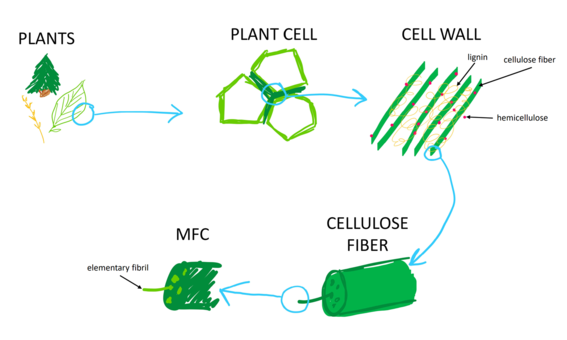
-What are the applications of nanocellulose? In which fields could it be used in the future and how could it help with various challenges that we are facing globally?
-This is a very multifaceted question as there is a wide range of possibilities within the material category, but in my thesis, I divided them into traditional and upcoming applications. The traditional ones I identified as composite reinforcements; for example, cellulose nanocrystals could replace glass fibers within modern construction composites. Another category is different kinds of fibers: one could make fabrics and clothes out of nanocellulose, as well as manifold types of specialty fabrics. Regarding the more novel applications, different components, capacitors and films could be produced. Furthermore, there is a multitude of diverse materials such as adhesives, biomedical wound dressings and so on. The way I see it is that there is a division into traditional applications which are maybe much more researched, and the novel ones which are just being proposed in research papers and are not that established yet.
Sustainability assessments
-It sounds really exciting that a range of current materials could be potentially replaced by nanocellulose! Let's move now to the sustainability subject: you also mentioned ‘greenwashing’ in your thesis, and that is an interesting concept. Could you please explain how you understand it and what risks there are if we look at sustainability with a narrow focus?
-I would like to note that I am not an expert on greenwashing specifically, but that is one of the topics I got familiar with in my Creative Sustainability studies. I quickly noticed that there is this approach of, for example, saying that a material is ‘natural’ or ‘bio-based’ and then using that statement as a positive implication - and it started to remind me of the ‘greenwashing’ phenomenon. There are various types of greenwashing, and in the thesis, I briefly covered which types, in my view, this material science greenwashing could go under. For me, greenwashing is using certain terms or ideas, implicating that they mean something sustainable or environmentally positive and then not proving these claims in any sense at all. And I think there is a lot of variety in how dangerous this can be or how much negative impact this can have. Of course, in marketing, for example, statements need to sell, thus, they can be rather provocative and maybe not very specific. But when we are talking about research and development, it is a bit worrisome to stand behind such statements without any factual data, and I discuss a lot in my thesis that these statements are often not referenced in any way. And if we start to participate in such delusions that, for example, ‘bio-based’ always means good, and we never really criticize this idea, it might have some wrong implications, and I don't think it's great science.
-You described three different methods of sustainability assessment in your paper. Could you please tell briefly about eco-efficiency and the Natural Step (TNS) and then focus more on the PESTEL which you chose as the analysis method for the case of biowaste crystalline nanocellulose (CNC) development in Finland?
-Together with my advisor and supervisor, we selected these three methods due to them being a bit different from one another but at the same time similar in the aspects that were of interest for this case specifically - the low technological readiness development phase. The eco-efficiency could be seen as a group of methods which are closely inspired by the LCA [life cycle assessment] and tend to focus on specific aspects of the development, e.g. on technological, economic or environmental perspectives. The main incentive in the eco-efficiency methods is to optimize, meaning that if you have an existing pilot stage process, you try to find out which step has, for example, the most emissions, and then you try to improve the situation. In the paper, I suggest that this method would be most suitable for pilot stages but not the earlier ones; moreover, it only focuses on the existing system and the problems that can be seen within the system but not on the broader scale, and much like many of the methods, it does not discuss social aspects.
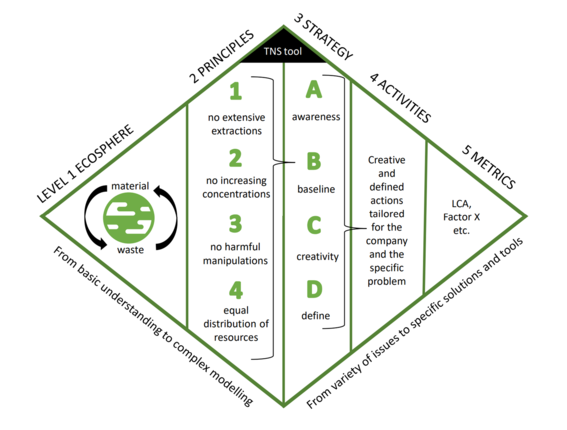
The Natural Step was a completely novel method to me, proposed by my advisor. As its name suggests, there is a set of steps that one needs to follow for the assessment. What makes it rather complicated is that simultaneously it is also a framework into understanding sustainability issues. The fact that the method aims to lessen the accumulation of potentially dangerous substances to our living environment is its biggest motivation and also its biggest problem as it is not very well scientifically defined. And maybe due to its complexity of being a method, a framework and of involving the idea of unknown accumulation of some substances, the Natural Step does not fit well into our approach of creating sustainable materials where it is important to understand what impact new materials might have.
PESTEL is a simple method similar to SWOT, and it is mostly used in management studies. What I really liked about PESTEL is that it comprises different dimensions such as political, economic, sociocultural (I would have liked to call it 'societal', as the cultural aspect was a bit difficult to connect in my work), technological, environmental, and legal. In material science, social aspects are very rarely discussed, therefore, I was anticipating that PESTEL could provide some new knowledge for us.
-You mentioned that the PESTEL method encompasses a broad range of various dimensions. Did you get any useful insights in any of these areas, or maybe in all of them, and was there anything completely new to you, something that really impressed you?
-The findings were definitely unexpected, in my view, and there were some really interesting angles. Moreover, interdisciplinarity within the PESTEL analysis was one of the most difficult things during the process, and I was really glad to get some external help, for example, with legal and political aspects, because I don’t know how I would have done it all on my own. The idea of even including political, sociocultural and legal aspects into this analysis was an indicator that there would be some new information because, at least to my knowledge, those dimensions had not been discussed in nanomaterial science or nanocellulose research before. Furthermore, conclusions within economic, technological and environmental aspects quite accurately aligned with the previously assumed environmental benefits of nanocellulose while giving them a new perspective.
It is worth mentioning that these different dimensions are not separate, they are linked to one another; for example, legal aspects are definitely affected by environmental changes and so on. It would be really exciting to create some sort of a mind map that would have illustrated it better! But maybe the most interesting findings about the future of nanocellulose production in Finland are the limitations of forestry usage and the actual negative environmental impacts that the increased cutting down of forests might bring, which is a really popular topic in Finland these days. Applying the planetary boundaries framework, taking into account different resources that biomaterials will be using, negative effects on biodiversity – all these points were a bit of a revelation, especially because in Finland the attitude is ‘yes, wood, we love wood, and wood is the best’! Therefore, giving an alternative angle to certain issues is really important. And, of course, within the legal aspects, for example, there are changes coming up in the waste framework directive concerning circular economy which sounds truly positive and promising.
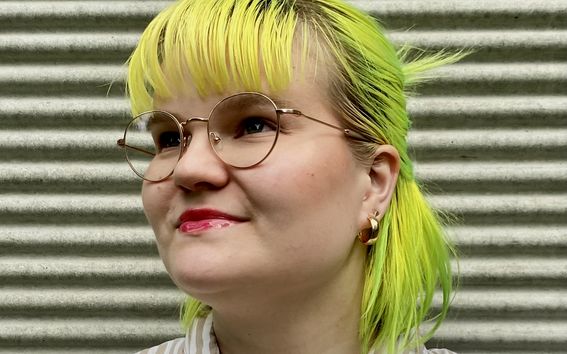
Riia VidgrenI have discovered that applying an interdisciplinary perspective is actually a really concrete and practical way to think outside the box.
Interdisciplinarity within research and education
-It is really interesting how you talk about interdisciplinarity in your thesis. How could this interdisciplinary aspect, in your opinion, be applied in the future in research teams, research projects, or in industry?
-This is definitely a passion topic for me! This year, we wrote a paper about interdisciplinary ways of working with Jaana [Vapaavuori], Mithila [Mohan] and Emmi Pouta from the Department of Design. And I think there are many practical tips about how to make it work, as we have discussed a lot that ‘these are the problems and this is how we could maybe make it better’. I would say that interdisciplinarity is my professional ethos, because in my studies and experiences so far, I have tried to combine my different backgrounds of knowledge which I have now concluded into this triangle tree framework including design, sustainability and material science. And I have discovered that applying an interdisciplinary perspective is actually a really concrete and practical way to think outside the box, not only for theorizing, but also for creating, as we saw in the novel actuators team really well ['Beyond e-Textiles' and 'ModelCom' projects]. Therefore, when talking about sustainability issues which are really complex systemic issues, we need this multitude of understanding to even start to comprehend all the different angles.
Regarding the practical tips, I think it is a good idea to have teams with people from different backgrounds, and then we also need to actually facilitate the work. Moreover, I think it is important to have people like me who actually have studied different fields and understand diverse languages of different professional backgrounds and could work as 'bridges'. In this thesis paper, I tried to combine and bridge different angles, such as technical, scientific, legal, etc. And to be honest, it is not easy, neither alone, nor in a group. And as problems are becoming more and more complex, the key to problem-solving would be to have these different ways of thinking - both in teams, and in individual people.
-So, would it mean that maybe the whole system of educating people should be transformed, making it more flexible, so that people would have several majors or several minors, to put it simply?
-I think that it would be great to provide different alternatives. It will not make sense if everyone is a 'jack of all trades', because I still can not do the work of someone who is specialized in nanocellulose, they will always know and see the subject from a completely different angle, and that is why diverse perspectives are important. For example, in Aalto there is a lot of potential, in my view, to encourage people to complete degrees that are inherently interdisciplinary. In practice, though, I have noticed this is sometimes a bit difficult. For my thesis topic, for instance, I had to find myself an advisor from the sustainability field, and then to act as a bridge in discussions between my supervisor and advisor, who are from different fields. Therefore, there is no need to change the whole education system, but to provide this opportunity to people when they are able to study various disciplines and combine this diverse knowledge and skills in their professional careers. Sadly, nowadays there are still quite few actual interdisciplinary professionals. And sometimes, when people start to get interested in another field, they completely switch to it, not trying to apply their previous experiences, maybe because they are not provided with enough tools to combine their different backgrounds.
Riia VidgrenIt would be very interesting to see how PESTEL would work in practice, for example, with this biowaste CNC case [cellulose nanocrystals].
-Hopefully, changes in this area will not keep us waiting for too long, as discussions on the importance of interdisciplinarity for solving various problems have become more and more frequent. Could you share with us some of your future plans? Would you like to continue exploring the same topic and what would you like to focus on later?
-I have been thinking a lot about that! I would really like to continue with this topic, maybe later on in my professional career. I think the next challening step would be the implementation. There are lots of different material development projects going on, for instance, at the School of Chemical Engineering. It would be interesting to choose a project, apply these sustainability assessment methods and see how this application process would go in reality. From the theoretical perspective - this is just an idea that I throw out at the end of the thesis - it would be really exciting to look into the different technological readiness level steps and to evaluate which assessment methods would be optimal for each step. And why I think this would make sense and would be important and why these assessments are relevant, is that they give a practical statement of sustainability, meaning that we are not basing our assumptions on just words and statements alone, but we could actually use the assessments within the development process. Then we would be able to claim that ‘yes, we have done this assessment, and this is our sustainability profile’. So, as the material development process continues, there is the sustainability development process that is evolving as well. It would be very interesting to see how PESTEL would work in practice, for example, with this biowaste CNC case [cellulose nanocrystals].
-That sounds really exciting! Surely, there are so many new materials that are being developed, and it is often rather challenging to predict how they might 'behave' in the future, therefore, sustainability assessments are so important. Would you like to add anything to conclude our conversation today?
-It's been very inspiring to discuss the subject of my thesis! I think that an overall message I would like to communicate is that for solving sustainability issues we need the 'interdisciplinarity' angle, and we need to apply a really scientific approach when we talk about sustainable materials and sustainability overall. I guess that's it, thank you!
Link to the Master's thesis by Riia Vidgren 'Sustainability Assessments for Novel Materials in Development: Crystalline Nanocellulose from Biowaste': http://urn.fi/URN:NBN:fi:aalto-202208285183
Link to the publication mentioned in the interview 'Intertwining Material Science and Textile Thinking: Aspects of Contrast and Collaboration': https://doi.org/10.21606/drs.2022.525
Related content:
Multifunctional Materials Design
Group led by Professor Jaana Vapaavuori

Read more news
Apply to be a guest professor or visiting researcher at the Université Grenoble Alpes
Unite! partner, Université Grenoble Alpes (UGA) has opened a call to host international professors and researchers for short stays.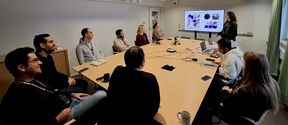
Floriane presents research findings on denim recycling
On 15 January 2026, Floriane Jacquin, an intern with the Textile Chemistry Group at Aalto University, presented the findings.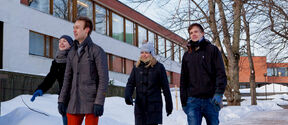
Sensory-friendly relaxation room voted students’ top idea
The winner of the 2025 participatory budgeting vote was announced at the end of November.






